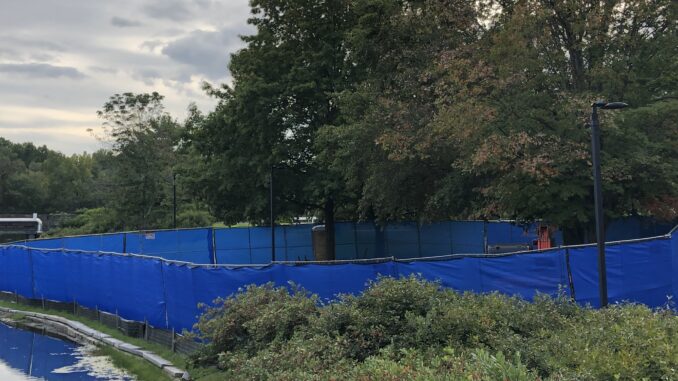
As our school year kicks off, you may have noticed a section of the walkway next to the Gunk in front of Peregrine Complex boarded up and under construction. This is our new and long awaited Contemplative Space being built.
The suggestion for this space came from the Diversity & Inclusion Council (D&I), an administrative group which is dedicated to diversifying and transforming our campus into an anti-racist and inclusive space.
Located on the west side of the Gunk, across from Peregrine Dining Hall, this space will include benches, garden beds and plaques that will display historical information about the New Paltz area, especially the history of the indigenous Esopus Munsee, enslaved Africans and early European immigrants whose vital contributions have made New Paltz what it is today.
This addition follows the inspection of the building names in Peregrine Complex, which were changed in 2019 because of the slaveholders they were namesake to, but now reflect the diverse regional history of the area before colonization.
The space was also suggested in 2019 along with the name changes, but construction has only begun now, because of the pandemic related restrictions on campus.
Diversity and Inclusion council’s Chief Diversity Officer, Tanhena Pacheco Dunn, says that the Contemplative Space is the next step in their mission, a project which will, “move us beyond the moment of name changes and will become a place where visitors can be reminded of the importance of thinking critically about history.”
Pacheco Dunn says that “the impact of changing names is important both for our campus culture but also for the transparency of our history.”
The changing of these building names was long overdue, a mark on our school that did not promote the kind of community that we at New Paltz want to have: one which includes every part of our history, equally and without bias.
The new names of Peregrine Complex (Ashokan, Shawangunk, Minnewaska, Mohonk, and Peregrine) were approved by a study group of College Council members, faculty, staff, students, alumni and a Historic Huguenot Street Board member.
Names were chosen from the results of a campus wide survey, and reflect the geographical locations of local features; for example, the easternmost building became Shawangunk hall because the Shawangunk Ridge is the easternmost of these features.
This Contemplative Space strives to make changes to our campus which will inspire education and invoke thoughtfulness about our collective past.
Hopefully this addition will encourage both students, faculty and visitors to come together and reflect on our history.
“It is wonderful to be able to see that recommendation come to fruition,” says Pacheco Dunn.
The project is now going to be put to bid via the State University Construction Fund.
The State University Construction Fund is a public benefit corporation which was created solely to help the SUNYs to design, construct, acquire and improve SUNY buildings and monuments. So, the D&I have hopes that their proposal will be allowed funding and the hold on construction will soon be lifted.
However, the council expects that construction will not begin until next fall, with completion in the spring of 2022.
Pacheco Dunn adds that she hopes the space will “bring visitors into reflection and exploration and make them curious to learn more.”
This year, the D&I look forward to working on a review of the campus’ Diversity and Inclusion Strategic Plan, which Pacheco Dunn says will, “help inform goals, initiatives, or projects that we would like to see accomplished in the future.”
She also adds that they look forward to “continuing our DEI work with various constituents of the campus, hearing from members of our campus about priorities and opportunities for which the D&I Council can be an ally and advocate.”
The significance of these changes to our campus cannot be underestimated; in order to become a more thoughtful and anti-rascist community, it is so important that we acknowledge and reflect on our past as a community. In the words of Pacheco Dunn, it is key that we continue to ponder “about whose history is told and reflected and whose history is silenced or forgotten.”

